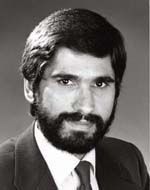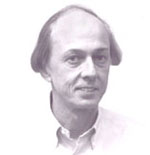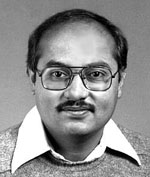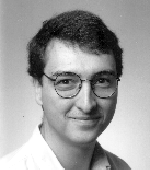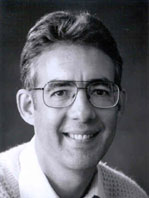2002 CONTROL AWARENESS DAYS
on
THE UBIQUITY OF CONTROL
December 11, 2002
The Venetian Hotel - Las Vegas, Nevada
in conjuction with the
IEEE 2002 Conference on Decision and Control
December 10 - 13, 2002
SPEAKERS LIST
| Stephen Boyd | Katsuhisa Furuta |
| Christos G. Cassandras | P.R. Kumar |
| Raffaello D'Andrea | Richard Murray |
| Theofore E. Djaferis | Mark Sprong |
| Tyrone Duncan |
TITLES / BIOS / ABSTRACTS
"Advances in Convex Optimization: Interior-Point Methods, Cone Programming, and Applications"Abstract: One of the definitions of the word "control" is "to govern or direct according to rule" (Merriam-Webster dictionary). In science and engineering, these "rules" have traditionally been dictated by the laws of nature - such as gravity or conservation of mass. Computer technology, however, has enabled us to build complex systems that have become essential to our daily life, from automated factories to computer networks, with intelligent highways and pilotless planes not too far in the horizon. The "rules" that these systems must obey are as arbitrary as human imagination can make them (as in designing a video game where one may create a virtual world where anything goes). While this is exciting, it is also dangerous - it takes but one minor "bug" or "virus" to bring a multimillion factory to a standstill, the Internet to crash, or the Mars exploration vehicle to erroneously "think" that its landing legs were deployed, effectively forcing it to commit electronic suicide. Many of the dangers of automation stem from the lack of designers and engineers with appropriate skills that are cultivated through an understanding of what a "system" is and how to evaluate the effectiveness of a controller before deployment. This presentation will employ simple computer simulation examples to illustrate the difference between physical processes subject to the laws of nature and human-made processes that must satisfy human-made rules. We will then show how "automatic control" can be used and demonstrate both its benefits and risks. |
"Joys and Perils of Automation"Abstract: One of the definitions of the word "control" is "to govern or direct according to rule" (Merriam-Webster dictionary). In science and engineering, these "rules" have traditionally been dictated by the laws of nature - such as gravity or conservation of mass. Computer technology, however, has enabled us to build complex systems that have become essential to our daily life, from automated factories to computer networks, with intelligent highways and pilotless planes not too far in the horizon. The "rules" that these systems must obey are as arbitrary as human imagination can make them (as in designing a video game where one may create a virtual world where anything goes). While this is exciting, it is also dangerous - it takes but one minor "bug" or "virus" to bring a multimillion factory to a standstill, the Internet to crash, or the Mars exploration vehicle to erroneously "think" that its landing legs were deployed, effectively forcing it to commit electronic suicide. Many of the dangers of automation stem from the lack of designers and engineers with appropriate skills that are cultivated through an understanding of what a "system" is and how to evaluate the effectiveness of a controller before deployment. This presentation will employ simple computer simulation examples to illustrate the difference between physical processes subject to the laws of nature and human-made processes that must satisfy human-made rules. We will then show how "automatic control" can be used and demonstrate both its benefits and risks. Bio: Christos G. Cassandras received the B.S. degree from Yale University, New Haven, CT, the M.S.E.E degree from Stanford University, Stanford, CA, and the S.M. and Ph.D. degrees from Harvard University, Cambridge, MA, in 1977, 1978, 1979, and 1982, respectively. From 1982 to 1984 he was with ITP Boston, Inc. where he worked on the design of automated manufacturing systems. From 1984 to 1996 he was a Faculty Member at the Department of Electrical and Computer Engineering, University of Massachusetts, Amherst. Currently, he is Professor of Manufacturing Engineering and Professor of Electrical and Computer Engineering at Boston University, Boston, MA. He specializes in the areas of discrete event and hybrid systems, stochastic optimization, and computer simulation, with applications to computer networks, manufacturing systems, transportation systems, and command-control systems. He has published over 200 papers in these areas, and two textbooks one of which was awarded the 1999 Harold Chestnut Prize by the IFAC. Dr. Cassandras is currently Editor-in-Chief of the IEEE Transactions on Automatic Control and has served on several editorial boards and as Guest Editor for various journals. He is a member of the IEEE Control Systems Society Board of Governors. He was received several awards, including a 1991 Lilly Fellowship. He is also a member of Phi Beta Kappa and Tau Beta Pi and a Fellow of the IEEE. |
"Control of Autonomous Vehicles"Abstract: We will discuss several multi-vehicle projects at Cornell University, including the world-champion Cornell RoboCup team -- a team of soccer playing robots. We will outline the importance of feedback, dynamics, and control when deploying autonomous systems that must interact with a rapidly changing environment. Bio: Raffaello D'Andrea obtained a Ph.D. in electrical engineering from the California Institute of Technology in 1997. Since then, he has been with the Department of Mechanical and Aerospace Engineering at Cornell University, where he is an Associate Professor. He is also a member of the Applied Mathematics, Electrical Engineering, and Theoretical and Applied Mechanics fields at Cornell. His research and teaching interests include the development and application of tools for controlling complex systems. Dr. D'Andrea has been the recipient of the American Control Council O. Hugo Schuck Best Paper award, an NSF Career Award, a DOD sponsored Presidential Early Career Award for Scientists and Engineers (PECASE), and was a Distinguished Lecturer in the NSF Research Highlight Series. He was the system architect and faculty advisor for the world champion Cornell Autonomous Robot Soccer team in 1999 (Stockholm, Sweden), 2000 (Melbourne, Australia), and 2002 (Fukuoka, Japan). He has appeared with the Cornell RoboCup team on Scientific American Frontiers (1999 and 2001), the Lemelson Center at the Smithsonian (1999), and the Tech Museum of Innovation in San Jose (2001). His recent collaboration with Canadian artist Max Dean "The Table: Childhood," an interactive installation, was on display at the Biennale di Venezia, the world's most prestigious contemporary art exhibit, and will be on exhibit at the National Gallery of Canada in 2003. |
"The Power of Feedback"Abstract: Feedback is ubiquitous in nature and humans encounter it on a daily basis in a multitude of situations. In fact, one can argue that life as we know it would not be possible without feedback. We are so used to it that in most cases we do not even notice its presence. Consider the task of walking. It would be impossible to walk without sensing our surroundings and using this information as we take our next step. The human body includes a multitude of feedback systems that operate automatically keeping us alive and well. Similarly, a great variety of man-made systems are designed to operate automatically using feedback. Consider cruise control in an automobile. It would be impossible to maintain a desired speed without measuring the actual vehicle speed and using this information to adjust the accelerator pedal. It is said that information is power and it is through the use of feedback that this is realized. Control Engineers strive to gain a better understanding of the advantages and limitations of feedback and employ the concept for the automatic control of systems. These are systems can have electrical, mechanical, chemical, hydraulic, financial or biological characteristics. Automatic control is a fascinating field of study. The theory and practices developed over the years can be applied to a wide range of automation problems, giving the field its universal character. Automatic control is truly multidisciplinary as problems frequently involve a number of disciplines. In this talk we shall explore the use of feedback in automatic control applications. Rather than talking in broad terms we will introduce the subject by considering a specific example. This will lead to a better understanding of the different pieces involved in the automatic control puzzle and the process used to solve problems. The example chosen is taken from the design of an automatic control system for vehicle collision avoidance. We will demonstrate the concepts by considering a collision avoidance automatic control system for a Computer Intelligent Model Car (CIMCAR). Bio: Theodore E. Djaferis received the B.S. degree from the University of Massachusetts Amherst in 1974, and the M.S., E.E. and Ph.D. degrees from the Massachusetts Institute of Technology in 1977, 1978 and 1979 respectively. In 1979 he joined the Electrical and Computer Engineering Department of the University of Massachusetts at Amherst where he is currently a full professor. He is the author of more than ninety technical publications in the area of systems and control.He is the author of the research monograph, Robust Control Design: A Polynomial Approach, published by Kluwer Academic Publishers in 1995. He is a co-editor of the research volume, System Theory: Modeling Analysis and Control, also published by Kluwer in 1999. He is the author of a textbook for first-year engineering students with the title, Automatic Control: The Power of Feedback, published by PWS in 1998 (revised printing by Brooks/Cole in 1999). He has held several editorial positions for the IEEE Control Systems Society, was involved with conference organization and currently serves on the Executive Committee. He is the recipient of the College of Engineering Outstanding Teaching Award in 2001. He is a member of Eta Kappa Nu and Tau Beta Pi and a Senior Member of the IEEE. |
"Brownian Motion: Past and Present"Abstract: Brownian motion and its formal derivative, white Gaussian noise, have been very useful in mathematical models of physical systems, in particular, control systems. Brownian motion and white Gaussian noise are used to model perturbations that occur to a physical system and the errors of approximation that occur in modeling a physical system. In 1836 a British botanist, Robert Brown, noted the erratic motion of pollen grains suspended in a liquid. This motion was subsequently called Brownian motion. While many attempts were made to give a physical explanation of this unusual motion, it was not until the beginning of the twentieth century that two physicists, A. Einstein and M. Smoluchowski, independently provided a correct physical explanation by constructing some aspects of Brownian motion from physical principles. At the same time L. Bachelier constructed some aspects of Brownian motion as a model for the Paris stock market. In 1923 N. Wiener gave a complete mathematical description for Brownian motion. Some of the unusual properties of Brownian motion are described as well as its use for modeling physical systems. Bio: Tyrone E. Duncan received his bachelorÔs degree from Rensselaer Polytechnic Institute and his masterÔs and doctoral degrees from Stanford University. He has held regular positions at the University of Michigan (1967-1971), the State University of New York-Stony Brook (1971-1974), and the University of Kansas (1974-present). He has held visiting positions for an academic year at the University of California-Berkeley (1969-1971), the University of Bonn (1978-1979), and Harvard University (1979-1980) and shorter visiting positions at many other institutions. Dr. Duncan has worked on a wide variety of aspects of stochastic analysis. He has a long history of research in stochastic filtering and control. He initiated some of the work on stochastic systems in manifolds. He has applied stochastic methods to geometry and Lie theory. In recent years, he has worked extensively on stochastic adaptive control for systems in both finite and infinite dimensions. He has made contributions to the mathematics of finance. Most recently, he has made initial contributions to stochastic systems with fractional Brownian motion. He is the author or co-author of more than 150 publications. He is a Corresponding Editor of SIAM Journal on Control and Optimization and is an IEEE Fellow. |
"Understanding Phenomena Through Real Physical Objects - Understanding Controlling Pendulum"Abstract: Pendulum has been a good example of physical objects which has observed behaviors for a long time. Galileo Galilei found that the pendulum swung around the pendant position with same period. The pendulum since then used for the mechanism for the clock. The pendulum then is found to keep upright when vibration is given to the hinge. Also by controlling the position of the hinge the pendulum can be swung up from the pendant to upright position. The control law for such swing up will be presented at the workshop with video. Bio: Katsuhisa Furuta was born in Tokyo, Japan in 1940. He received his BS. MS., and Ph.D.degrees in Engineering from Tokyo Institute of Technology in 1962, 1964, and 1967, respectively. He had been Professor of Control Engineering, Tokyo Institute of Technology till the end of March in 2000. He was a Russell Severance Springer Visiting Professor, University of California at Berkeley in March 1997. He is currently Professor at Tokyo Denki University, Department of Computers and Systems Engineering. Katsuhisa Furuta has been a Member of Science Council of Japan since 1997. From 1994 to 1999 he was a Council Member of IFAC and the editor of Automatica in application from 1996 to 1999. He is now serving the Research Supervisor of Mine Detection and Clearance Activities, Japan Science and Technology, Co. from this June, 2002. Katsuhisa Furuta received an honorary doctorate from Helsinki University of Technology in 1998, and international awards including of IEEE CSS Distinguished Member in 1998, IEEE Third Millennium Medal in 2000. He is a Fellow of SICE and IEEE. |
"How the Internet and Wireless Networks are Controlled: What's happening behind the screen"Abstract: How do wireless networks work? What challenges arise? We will provide an account of what takes place behind the scenes in order to make the network work. Bio: P. R. Kumar is the Franklin W. Woeltge Professor of Electrical and Computer Engineering, and a Research Professor in the Coordinated Science Laboratory, at the University of Illinois, Urbana-Champaign. He was the recipient of the Donald P. Eckman Award of the American Automatic Control Council. He has presented plenary lectures at the SIAM Annual Meeting and the SIAM Control Conference in 2001, the IEEE Conference on Decision and Control in San Antonio, Texas, 1993, the SIAM Conference on Optimization in Chicago, 1992, the SIAM Annual Meeting at San Diego, 1994, The Fifth Stochastik-Tage: German Open Conference on Probability and Statistics, Magdeburg, Germany, 2002, 10th Mediterranean Conference on Control and Automation, Lisbon, 2002, Brazilian Automatic Control Congress, and the Third Annual Semiconductor Manufacturing, Control and Optimization Workshop. He is a co-author with Pravin Varaiya of the book, ``Stochastic Systems: Estimation, Identification and Adaptive Control.'' He serves on the editorial boards of Communications in Information and Systems, Journal of Discrete Event Dynamic Systems; Mathematics of Control Signals and Systems; Mathematical Problems in Engineering: Problems, Theories and Applications; and in the past has served as Associate Editor at Large for IEEE Transactions on Automatic Control; Associate Editor of SIAM Journal on Control and Optimization; Systems and Control Letters; Journal of Adaptive Control and Signal Processing; and the IEEE Transactions on Automatic Control. He is a Fellow of IEEE. Professor Kumar's current research interests are in wireless networks, distributed real-time systems, wafer fabrication plants, and machine learning. |
"Control of Jet Engines"Abstract: In this talk, I will describe the use of control in gas turbine engines, of the sort that are used to power commercial and military aircraft. Computer control of jet engines is now present on all modern engines and is an essential element for robust performance of these machines. This talk will give a brief overview of the role of engine technology in aerospace applications and the use of control for maintaining high performance operation over thousands of hours of operation. Examples from Pratt & Whitney, a leading manufacturer of aircraft engines, will be given. Bio: Richard M. Murray received the B.S. degree in Electrical Engineering from California Institute of Technology in 1985 and the M.S. and Ph.D. degrees in Electrical Engineering and Computer Sciences from the University of California, Berkeley, in 1988 and 1991, respectively. He is currently a Professor of Mechanical Engineering and the Chair of the Division of Engineering and Applied Science at the California Institute of Technology, Pasadena. In 1998-99, Professor Murray was the Director of Mechatronic Systems at the United Technologies Research Center. His research interests include nonlinear control of mechanical systems with applications to aerospace vehicles and robotic locomotion, active control of fluids with applications to propulsion systems, and nonlinear dynamical systems theory. |
"Future Careers in Embedded Systems, Mechatronics, and Control"Abstract: Embedded systems are becoming pervasive in modern society. The average person encounters dozens of microprocessors daily that provide communication, computing, and control in applications such as telecommunication systems, automobiles, airplanes, factories, schools, banks, and hospitals. A key to future applications lies in the integration of sensing, actuation, and control in these so-called mechatronic systems. In this talk we will outline some of the exciting future career opportunities of control and mechatronics including automotive telematics, biomedicine, and robotics. We will discuss mechatronics education at the University of Illinois from our freshmen discovery program to our senior level and graduate level courses. Some videos of student projects will be shown including a robot that plays air hockey. Bio: Mark W. Spong received the B.A. degree, magna cum laude, in mathematics and physics from Hiram College in 1975, the M.S. in mathematics from New Mexico State University in 1977, and the M.S. and D.Sc. degree in systems science and mathematics in 1979 and 1981, respectively, from Washington University in St. Louis. He was on the faculty of Lehigh University and Cornell University prior to joining the University of Illinois at Urbana-Champaign in 1984. At Illinois he is currently Professor of General Engineering and Acting Director of the Coordinated Science Laboratory. In addition, he is Director of the College of Engineering Robotics and Automation Laboratory, which he founded in 1987 and the John Deere Mechatronics Laboratory, which he founded in 1995. He has held visiting positions at the University of Waterloo, Canada, the CINVESTAV del IPN, Mexico City, The Lund Institute of Technology, Sweden, The Laboratoire d'Automatique de Grenoble, France, The Universite de Tecnologie de Compiegne, France, the Katholiek Universiteit, Leuven, Belgium, The National University of Singapore, and the Technical University of Munich. Dr. Spong's main research interests are in robotics, mechatronics, and nonlinear control theory. He has published over 150 technical articles in control and robotics and is co-author of two books. Within the IEEE he served as Vice President for Publication Activities of the Control Systems Society from 2000-2002, Editor-in-Chief of the Transactions on Control Systems Technology from 1997-2000, and has been an Associate Editor for the Transactions on Automatic Control, the Transactions on Control Systems Technology and the Control Systems Magazine. He served on the Board of Governors of the Control Systems Society from 1994-2002. Dr. Spong is a Fellow of the IEEE and a member of Phi Beta Kappa. He received the Senior Scientist Research Award from the Alexander von Humboldt Foundation, Bonn, Germany, in 1999 and the IEEE 3rd Millennium Medal in 2000. In addition, he is President of Mechatronic Systems, Inc., a company that he founded in 1996. |
Updated 12/05/02
